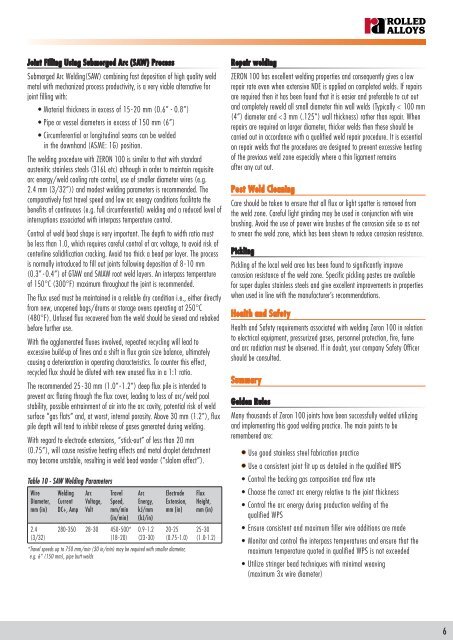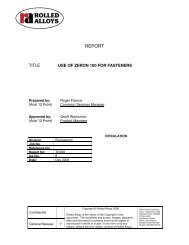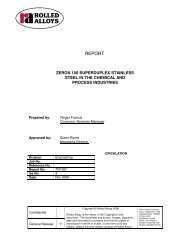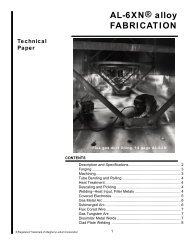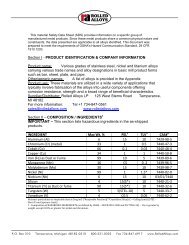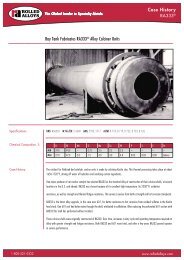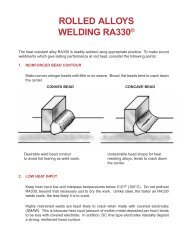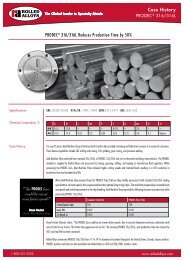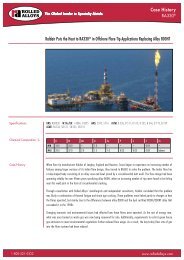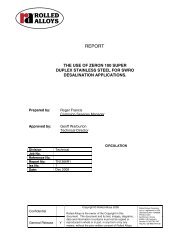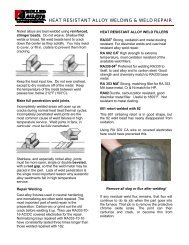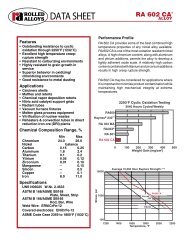ZERON 100 Welding Guide [Corrosion Resistant ... - Rolled Alloys
ZERON 100 Welding Guide [Corrosion Resistant ... - Rolled Alloys
ZERON 100 Welding Guide [Corrosion Resistant ... - Rolled Alloys
Create successful ePaper yourself
Turn your PDF publications into a flip-book with our unique Google optimized e-Paper software.
Joint Filling Using Submerged Arc (SAW) Process<br />
Submerged Arc <strong>Welding</strong>(SAW) combining fast deposition of high quality weld<br />
metal with mechanized process productivity, is a very viable alternative for<br />
joint filling with:<br />
• Material thickness in excess of 15-20 mm (0.6” - 0.8”)<br />
• Pipe or vessel diameters in excess of 150 mm (6”)<br />
• Circumferential or longitudinal seams can be welded<br />
in the downhand (ASME: 1G) position.<br />
The welding procedure with <strong>ZERON</strong> <strong>100</strong> is similar to that with standard<br />
austenitic stainless steels (316L etc) although in order to maintain requisite<br />
arc energy/weld cooling rate control, use of smaller diameter wires (e.g.<br />
2.4 mm (3/32”)) and modest welding parameters is recommended. The<br />
comparatively fast travel speed and low arc energy conditions facilitate the<br />
benefits of continuous (e.g. full circumferential) welding and a reduced level of<br />
interruptions associated with interpass temperature control.<br />
Control of weld bead shape is very important. The depth to width ratio must<br />
be less than 1.0, which requires careful control of arc voltage, to avoid risk of<br />
centerline solidification cracking. Avoid too thick a bead per layer. The process<br />
is normally introduced to fill out joints following deposition of 8 - 10 mm<br />
(0.3” - 0.4”) of GTAW and SMAW root weld layers. An interpass temperature<br />
of 150°C (300°F) maximum throughout the joint is recommended.<br />
The flux used must be maintained in a reliable dry condition i.e., either directly<br />
from new, unopened bags/drums or storage ovens operating at 250°C<br />
(480°F). Unfused flux recovered from the weld should be sieved and rebaked<br />
before further use.<br />
With the agglomerated fluxes involved, repeated recycling will lead to<br />
excessive build-up of fines and a shift in flux grain size balance, ultimately<br />
causing a deterioration in operating characteristics. To counter this effect,<br />
recycled flux should be diluted with new unused flux in a 1:1 ratio.<br />
The recommended 25 - 30 mm (1.0”- 1.2”) deep flux pile is intended to<br />
prevent arc flaring through the flux cover, leading to loss of arc/weld pool<br />
stability, possible entrainment of air into the arc cavity, potential risk of weld<br />
surface “gas flats” and, at worst, internal porosity. Above 30 mm (1.2”), flux<br />
pile depth will tend to inhibit release of gases generated during welding.<br />
With regard to electrode extensions, “stick-out” of less than 20 mm<br />
(0.75”), will cause resistive heating effects and metal droplet detachment<br />
may become unstable, resulting in weld bead wander (“slalom effect’’).<br />
Table 10 - SAW <strong>Welding</strong> Parameters<br />
Wire<br />
Diameter,<br />
mm (in)<br />
2.4<br />
(3/32)<br />
<strong>Welding</strong><br />
Current<br />
DC+, Amp<br />
Arc<br />
Voltage,<br />
Volt<br />
Travel<br />
Speed,<br />
mm/min<br />
(in/min)<br />
280-350 28-30 450- 500*<br />
(18 -20)<br />
Arc<br />
Energy,<br />
kJ/mm<br />
(kJ/in)<br />
0.9-1.2<br />
(23-30)<br />
Electrode<br />
Extension,<br />
mm (in)<br />
20-25<br />
(0.75-1.0)<br />
*Travel speeds up to 750 mm/min (30 in/min) may be required with smaller diameter,<br />
e.g. 6” (150 mm), pipe butt welds<br />
Flux<br />
Height,<br />
mm (in)<br />
25 -30<br />
(1.0-1.2)<br />
Repair welding<br />
<strong>ZERON</strong> <strong>100</strong> has excellent welding properties and consequently gives a low<br />
repair rate even when extensive NDE is applied on completed welds. If repairs<br />
are required then it has been found that it is easier and preferable to cut out<br />
and completely reweld all small diameter thin wall welds (Typically < <strong>100</strong> mm<br />
(4”) diameter and < 3 mm (.125”) wall thickness) rather than repair. When<br />
repairs are required on larger diameter, thicker welds then these should be<br />
carried out in accordance with a qualified weld repair procedure. It is essential<br />
on repair welds that the procedures are designed to prevent excessive heating<br />
of the previous weld zone especially where a thin ligament remains<br />
after any cut out.<br />
Post Weld Cleaning<br />
Care should be taken to ensure that all flux or light spatter is removed from<br />
the weld zone. Careful light grinding may be used in conjunction with wire<br />
brushing. Avoid the use of power wire brushes at the corrosion side so as not<br />
to smear the weld zone, which has been shown to reduce corrosion resistance.<br />
Pickling<br />
Pickling of the local weld area has been found to significantly improve<br />
corrosion resistance of the weld zone. Specific pickling pastes are available<br />
for super duplex stainless steels and give excellent improvements in properties<br />
when used in line with the manufacturer’s recommendations.<br />
Health and Safety<br />
Health and Safety requirements associated with welding Zeron <strong>100</strong> in relation<br />
to electrical equipment, pressurized gases, personnel protection, fire, fume<br />
and arc radiation must be observed. If in doubt, your company Safety Officer<br />
should be consulted.<br />
Summary<br />
Golden Rules<br />
Many thousands of Zeron <strong>100</strong> joints have been successfully welded utilizing<br />
and implementing this good welding practice. The main points to be<br />
remembered are:<br />
• Use good stainless steel fabrication practice<br />
• Use a consistent joint fit up as detailed in the qualified WPS<br />
• Control the backing gas composition and flow rate<br />
• Choose the correct arc energy relative to the joint thickness<br />
• Control the arc energy during production welding of the<br />
qualified WPS<br />
• Ensure consistent and maximum filler wire additions are made<br />
• Monitor and control the interpass temperatures and ensure that the<br />
maximum temperature quoted in qualified WPS is not exceeded<br />
• Utilize stringer bead techniques with minimal weaving<br />
(maximum 3x wire diameter)<br />
6


